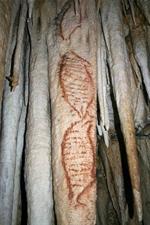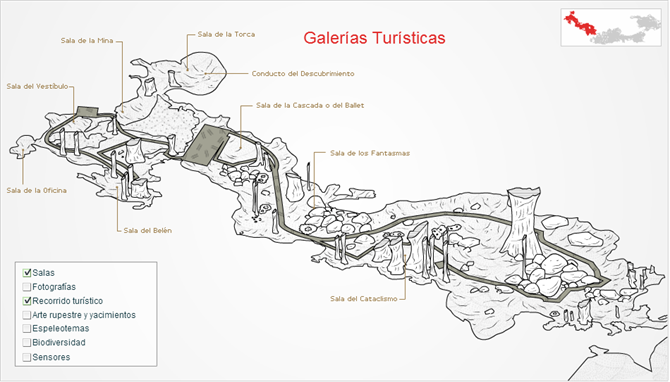The history of the Nerja caves
The caves were discovered on January 12th 1959, by five local boys from the nearby village of Maro. They had spent the night watching bats coming into and leaving a local pothole known as "La Mina" - the mine.
They decided to explore further, chipping away at some of the rocks and stalagmites that blocked the entrance.
What they discovered was nothing short of spectacular. The first large cavern they came across contained several skeletons and ceramics. They had inadvertently stumbled on one of the most important geological finds of our era.
In the words of Professor Jose Luis Sanchidrian, from the University of Cordoba, describing the recent carbon dating of six seal paintings as "an academic bombshell" and having "no parallel in Palaeolithic art."
Oldest paintings in the world
 The six paintings of seals are the only known artistic images created Neanderthal man.
The six paintings of seals are the only known artistic images created Neanderthal man.
Their age has been put between 42,300 and 43,500 years old.
Making them by far the oldest works of art in the world and a good 10,000 years older than the previous record holder, the 32,000-year-old images in the Chauvet Cave in southern France.
Neanderthal man, until very recently, was considered as ape-like and incapable of symbolism and creating artistic works. The cave paintings have dispelled this myth.
World's largest column
The Nerja caves are home to the world's largest column (formed by the merging of a stalagmite and a stalactite) at 32m in height and 13x7m at its base, it has held its place in the Guinness book of world records since 1989.
Traces of pottery, ceramics, prehistoric tools, human remains and wall paintings have all been found within the caves. Since the caves discovery over fifty years ago, more than one million pieces have been discovered and catalogued.
The caves were inhabited during the Paleolithic period. It is widely believed that humans inhabited the caves for about 4,000 years from about 25,000BC – right up to the Bronze Age.
Wall paintings and skeletal remains indicate that the caves were lived in seasonally, by small groups of humans. Packs of hyena used the caves as a base during their absence.
By 21,000BC, the human population began to use the caves as a more permanent dwelling and also increased substantially in number. Shells, animal and fish bones pointed to a more advanced and permanent ‘society,’ that was making increasing use of pottery and tools.
By 3,800BC, there was some form of organized farming around the caves and parts of the caves were used as burial chambers.
Newer archaeological finds
New archaeological discoveries point to more recent civilizations having some form of association with the caves. Pieces of Roman pottery and a Moorish/Arab coin have generated a lot of speculation.
Blind scorpions and scarab beetles, until recently believed to be extinct, have also been documented.
Visiting the Nerja caves
The Nerja caves run for almost five kilometres and has been divided up into two sections, Nerja I and Nerja II.
Nerja I is accessible to the public, while the Nerja II section is closed to public viewing. Indeed, only a quarter of the cave’s surface area is open to the public.
Nearly all of these newer discoveries have been made in the Nerja II section, which is ‘closed’ to the general public. It is possible to join a speleological, study group, to gain access to this part of the complex.These study groups consist of a maximum of 10 people, minimum age of 14 and require no particular expertise. For more information on these specialist tours - see here.
General visits take place in the so-called "Tourist Galleries."

The caves are impressive in the sheer scale of its chambers, with several being of particular importance. The ‘Sala de la Cascada’ (waterfall/cascade chamber) is also known as the ‘Sala de Ballet’ (the ballet chamber), adeptly named as it hosts the annual festival of Music and Dance in the second or third week of June.
Just next door is the ‘Sala de los Fantasmas’ (the ghost chamber), that leads quickly onto the impressive ‘Sala del Cataclismo’ (Cataclysm chamber). Home to the world's largest column.
There are quite a few steps and landings to cross throughout the tour. A responsible level of fitness is required, however, there are numerous benches and viewing platforms where you can rest. There is a restaurant, souvenir shop and a large children's playground/picnic area within the complex. A great day out for the whole family.
Practical information
Opening hours – winter months 10:00 – 14:00 and 16:00 to 18:30. In the summer months – July and August – the caves are open from 10:00 until 19:30.
The caves are situated three kilometers east of Nerja, near a village called Maro and are well signposted. Take the E-15 A7 motorway eastwards – direction Motril – coming off at junction 295 – signposted – Cuevas de Nerja/Maro. Taking a left at the roundabout, past the 19th century Roman aqueduct and keep following the signs for the Cuevas de Nerja – map.
Prices – €8.50 for adults, children €4.50 (6-12yrs) and under six go for free.
Telephone number – +34 952529520 and website.
